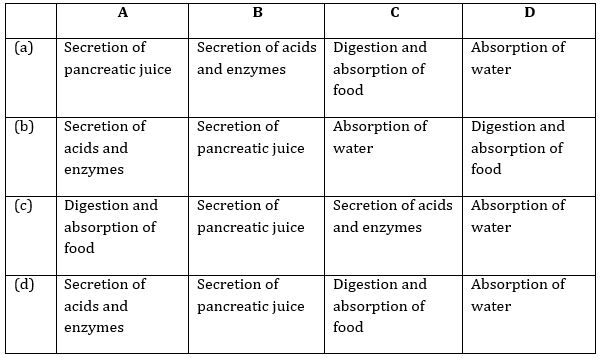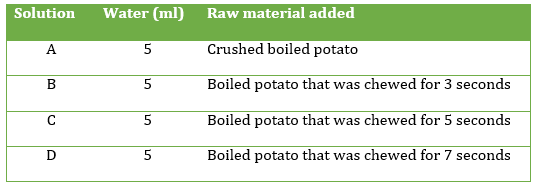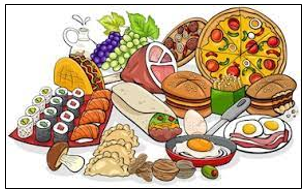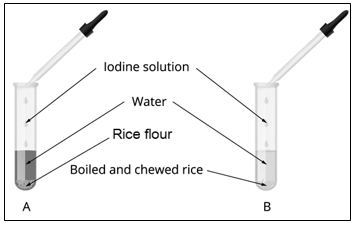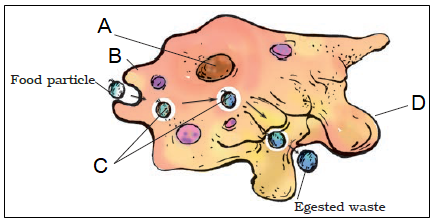Nutrition in Animals Worksheets
Objective Type Questions
- Fill in the blanks with suitable words.
(a) The largest gland in the human body is …………….
(b) The inner wall of the small intestine has several finger-like outgrowths called …………….
(c) The ……………. together with the associated glands constitutes the digestive system.
(d) The inner lining of the stomach secretes mucous, ……………. and digestive juices.
(e) The tongue has ……………. to detect different tastes of food. - Find the odd one out.
Lice, Hummingbirds, Houseflies, Snakes - Match the terms in column A with appropriate terms in column B.

Multiple Choice Questions - The given picture depicts a honeybee obtaining nectar from the flowers. This mode of feeding is called
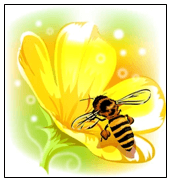
(a) Chewing
(b) Swallowing
(c) Siphoning
(d) Sucking
- The image shows a frog acquiring food with the help of its tongue.
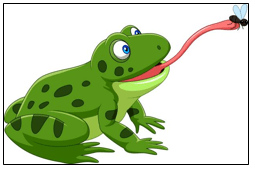
Sahil observed this image and claimed that the frog obtains its food by sucking. Is the claim made by Sahil, correct?
(a) No; the frog is eating food as a whole, so its mode of feeding is swallowing.
(b) No; the frog is using teeth to break its food, so its mode of feeding is chewing.
(c) Yes; the frog is sucking the insect inside its mouth as is done for liquids, so its mode of feeding is sucking.
(d) Yes; the frog is using its body to grind up the insect, so its mode of feeding is grinding. - The given chart lists some animals that acquire their food with different modes of feeding.

Which two animals have the same mode of feeding?
(a) Lice and Butterfly
(b) Frog and Snail
(c) Snails and Snakes
(d) Butterfly and Ants - The table shows few animals classified into two groups, 1 and 2, based on their mode of feeding.
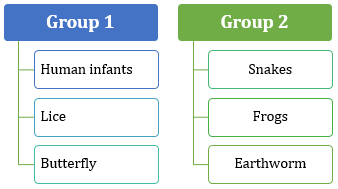
Which other animals can be included in group 1 and group 2?
(a) Group 1-Ants; Group 2-Snails
(b) Group 1-Bees; Group 2-Lizards
(c) Group 1-Snails; Group 2-Sucking
(d) Group 1-Spiders; Group 2-Housefly
- The below diagram shows an unlabelled sketch of the human digestive system.
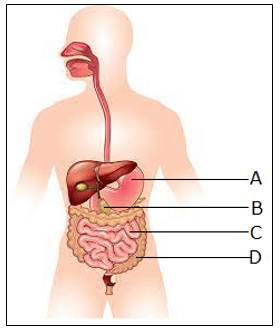
Which of the following correctly describes the functions of the parts marked as A, B C and D? - A patient complained of nausea, bloating and abdominal pain. After medical examination, the doctor reported this as a case of improper digestion of fats in the body. According to the doctor, the organ that secretes bile has been damaged due to consumption of excessive alcohol by the patient. Which organ of the patient has been damaged?
(a) Kidney
(b) Liver
(c) Lungs
(d) Pancreas - The table shows the contents of four different solutions.
Which solution is likely to have the highest amount of starch?
(a) A
(b) B
(c) C
(d) D - Humans chew food only when they have food in their mouth, but buffaloes chew continuously even when they are not eating grass. What could be the reason behind this?
(a) Buffaloes chew continuously because they store undigested grass in their mouth.
(b) Buffaloes chew continuously to remove the stuck food particles from their mouth parts.
(c) Buffaloes chew continuously because cud, the partially digested food, returns to their mouth in small lumps.
(d) Buffaloes chew continuously to collect saliva in their mouth so that more bacteria can be formed in their mouth. - In some grass-eating animals such as horses and rabbits, a sac-like structure is present between the oesophagus and the small intestine. It helps these animals to digest the cellulose present in food. This structure is absent in humans. What is the name of this structure, and how is it able to digest cellulose?
(a) Rumen; the presence of certain bacteria that are absent in humans
(b) Rumen; the presence of certain proteins that are absent in humans
(c) Caecum; the presence of certain bacteria that are absent in humans
(d) Caecum; the presence of certain proteins that are absent in humans
Subjective Questions - Jatin was eating his breakfast hurriedly as he wanted to reach the railway station on time. Suddenly, while eating, Jatin began to cough and felt a choking sensation in his throat. What could be the reason behind this?
- Which part of the alimentary canal participates in the following processes?
Choose the correct terms from those given in the brackets.
(a) Chewing of food
(b) Killing of bacteria
(c) Complete digestion of food
(d) Formation of faeces - Observe the figure showing the different regions of the tongue.
(a) What are regions 1, 2, 3, and 4 collectively referred to as?
(b) Identify 1, 2, 3, and 4.
(c) Which region of the tongue will be able to tell the taste of lemon juice?
(d) Give two examples of foods whose taste can be detected at regions 1 and 4.
Case-Based Questions - The food we eat contains a lot of complex, insoluble nutrients. These nutrients cannot be directly absorbed by the body. They must be broken down into smaller, soluble molecules which can be easily absorbed by the blood.
a) Which life process helps to break down the food?
(a) Digestion
(b) Egestion
(c) Nutrition
(d) Excretion
b) What role does the human digestive system play in the body? - An experimental set up was placed in front of Sana during her practical exam. The set up consisted of two test tubes A and B. Test tube A contained a slurry of rice flour while test tube B contained a slurry of boiled and chewed rice. Sana was required to add iodine solution to both the test tubes and note down her observations.
a) What will be Sana’s observation after adding iodine solution to both the test tubes?
(a) Test tube A showed colour change to blue-black but there was no colour change in test tube B.
(b) Test tube A showed no colour change but test tube B showed colour change to blue-black.
(c) Both test tube A and test tube B showed colour change to blue-black.
(d) Both test tube A and test tube B did not show any colour change.
b) How will you interpret the observations in the above experiment? Explain.
c) Which of the following statements is true with respect to the above experiment?
(a) Chewing adds starch in the food, which converts the amino acids into proteins.
(b) Chewing adds saliva in the food, which converts the starch into sugars.
(c) Chewing adds saliva in the food, which converts the sugar into starch.
(d) Chewing adds starch in the food, which converts the proteins into amino acids.
d) If we had to replace rice flour with some other ingredient, which of the following would you use to obtain the same results as above?(a) Orange juice
(b) Moong dal
(c) Mustard oil
(d) Boiled potato - Amoeba feeds on some microscopic organisms. It pushes out one, or more finger-like projections, called pseudopodia or false feet for movement and capture of food.
a) The given chart lists the steps involved in food intake by Amoeba.
Which of the following is the correct sequence of steps?
(a) A → B → C → D
(b) A → C → B → D
(c) B → A → C → D
(d) B → C → A → D
b) The given image shows the process of obtaining food by Amoeba. A researcher wants to work on that component of Amoeba in which secretion of digestive juices takes place. Which label in the image represents that component?
(a) A
(b) B
(c) C
(d) D
Assertion-Reasoning Questions
Below questions consist of two statements – Assertion (A) and Reason (R). Answer these questions selecting the appropriate option given below: - Assertion (A): A person suffering from diarrhoea must be given ORS many times a day.
Reason (R): Diarrhoea leads to loss of water and salts from the body of a person. - Assertion (A): Alternate contractions and relaxations of the muscles of the stomach produce a wave-like movement called peristalsis.
Reason (R): Peristalsis helps to push food downwards in the alimentary canal.
Explore more Science Sample papers and Solutions
-
Sample Papers for CBSE Class 7 Science Term 1 #1
-
Sample Papers for CBSE Class 7 Science Term 2 #1
-
Nutrition in Plants Worksheet
- Heat Worksheet
- Acids, Bases And Salts Worksheet
- Physical And Chemical Changes Worksheet
- Respiration in Organisms Worksheet
- Transportation In Animals And Plants Worksheet
- Reproduction in Plants Worksheet
- Motion And Time Worksheet
- Electric Current And Its Effects Worksheet
- Light Worksheet
- Forests: Our Lifeline Worksheet
- Wastewater Story Worksheet
- Competency Based Questions for CBSE Class 7 Science
- Sample Papers for CBSE Class 7 Science Term 1 #2
- Sample Papers for CBSE Class 7 Science Term 2 #2
Key Features of Study Materials of CBSE Class 7 Science:
- Easiest and most comprehensive study materials
- Designed by subject matter experts
- Revised according to the latest CBSE syllabus
- Helpful for quick revision
- ‘Ask a Doubt’ facility
- Significant improvement in marks

